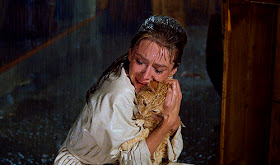Ariela Guerrero
How Music Enhances a
Scene
The last scene in Breakfast
at Tiffany’s always makes me feel so many emotions. I believe what makes
the scene so emotional is the music. As composer Gabriel Yared said, “[Music]
is meant to elevate the audience and have a timeless nature.” It is for the
heightened emotions that I chose to write my second blog post on this movie
theme song. The scene starts out with sadness and desperation and ends up
romantic and hopeful. At the beginning when Holly is desperately looking for
her cat and crying, the music is just slow and makes you feel desperate and
sad. When she still can’t find him, she stops and has a very worried look on
her face. At that moment, the music enhances the point of the scene because it
peaks off, the pace is faster and it becomes louder. The fact that the pace and
loudness of the music have increased indicate that something is about to
happen. “Loud sounds tend to be forceful, intense and threatening. Quiet sounds
strike us as delicate, hesitant, and often weak.” (Giannetti, 208) This quote
accurately describes what is happening here. At the beginning she is weak and
sad, so the music is quiet. Then, when the music becomes louder, it is
threatening because something is about to happen. What happens is that Fred,
her lover appears, and the music becomes even louder and changes into a tone of
hope and resolution, and she finds Cat. She hugs and cuddles Cat for like a
minute, which would be ridiculous if it weren’t for the music that makes it
sweet. As she turns to Fred and they kiss, the song becomes a lyric song as
opposed to just music, which makes it more romantic.
Besides
the music there are other sound factors that enhance this scene, such as
Holly’s tone of voice. As Giannetti said in his book Understanding Movies, “Tone of voice can be far more communicative
than words...” (Giannetti, 205) In this scene Holly’s tone of voice becomes
louder as she continues to search for her cat. The fact that her tone becomes
louder indicates that she is becoming more worried. Another factor in this
scene is the rain, this appeals to pathos because it enhances the emotions of
the audience. “Like most diplomats, he’s skilled in hiding his feelings, but
the sorrow that overwhelms him is poetically suggested by the sound of falling
rain, as though even the heavens are weeping for his loss.” (Giannetti, 210) In
this quote from Understanding Movies,
we can see how the rain can fill a scene with sorrow.
Besides
the final scene, there are other scenes in the movie that are affected by
music. Giannetti said, “Beginning with the opening credits, music can serve as
a kind of overture to suggest the mood or spirit of the film as a whole.”
(Giannetti, 208) In the opening scene the music is a classical and slow suggesting
the movie will be romantic and a somewhat sad. This type of music is used
frequently through the movie to make scenes sadder, or more romantic. I believe
that music in a movie can also appeal to logos because it can tell you a lot
about the time period. In this movie for example, there is a scene when Holly
makes a party in her house in which the music is characteristic of the 60’s.
In
the scene where Holly sings the famous song Moon
River, the lyrics in the song appeal to logos because they make us
understand she is singing about Fred. In his book, Louis Giannetti explains how
characterization can be achieved by adding lyrics to a song. The song says,
“We’re after the same rainbow’s end”. This indicates the song is about her and Fred, because both
where in search for money, and they both lived out of services in bed. This
song also appeals to ethos because it became so famous and characteristic that
it gives the movie credibility. Moreover, music is used in this movie about two
times to create suspense.
I
gave a rating of 5 slurpees because based on the above examples I came to the
conclusion that the music accurately enhances what the directors are trying to
point out throughout the whole movie, not just one scene.



No comments:
Post a Comment